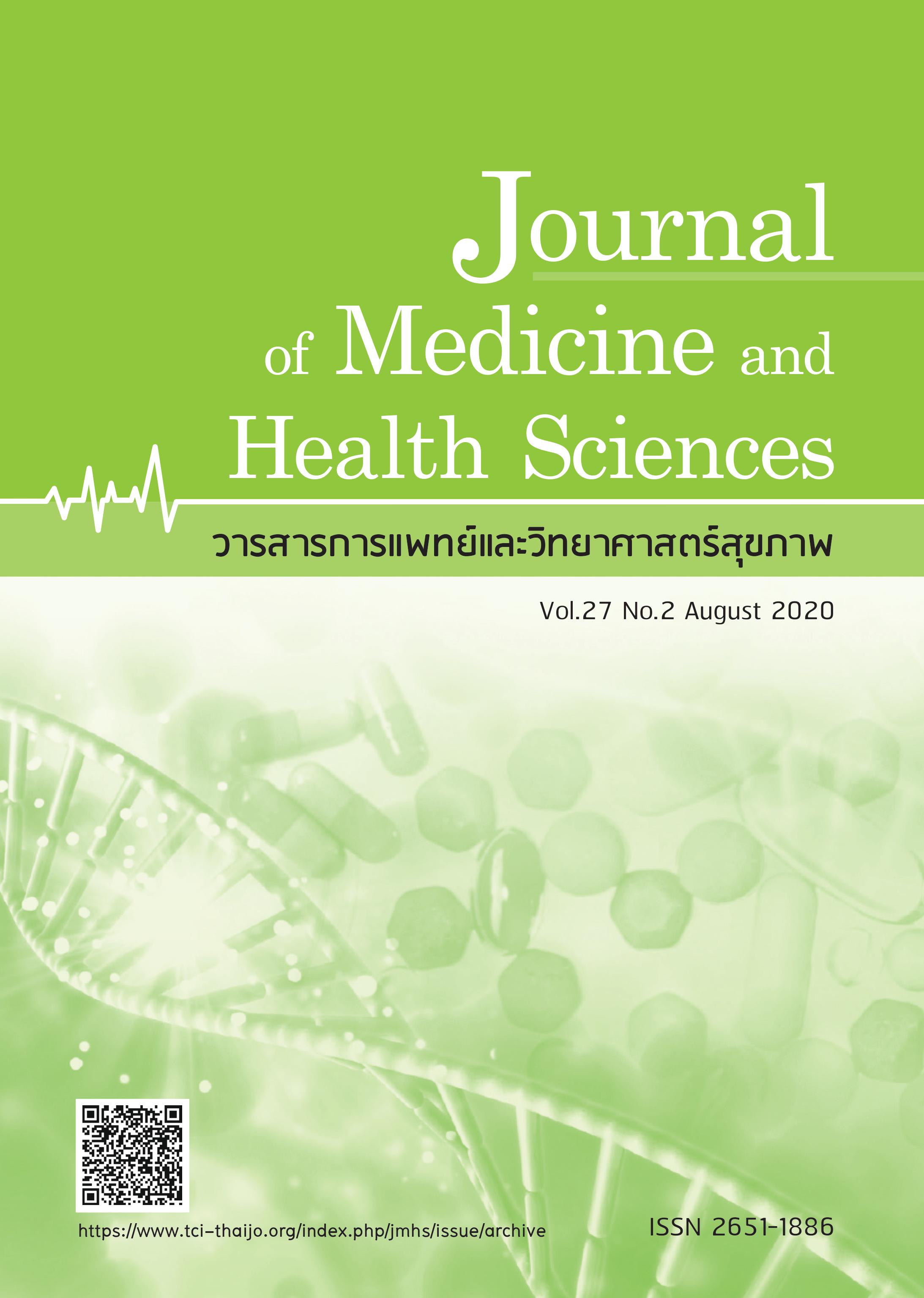Prevalence of laryngopharyngeal reflux in health annual check-up population at HRH Princess Maha Chakri Sirindhorn Medical Center
Keywords:
laryngopharyngeal reflux, health checkup, reflux symptom indexAbstract
Laryngopharyngeal reflux (LPR) is commonly diagnosed in otolaryngology clinic and negatively effects to the quality of life. This study aims to establish the prevalance of laryngopharyngeal reflux in health check up population at HRH Princess Maha Chakri Sirindhorn medical center and identify associated factors. The study design is a cross-sectional study. The data was collected from 1st June to 31st December 2013. All subjects were given the reflux symptom index (RSI) in Thai version. The validity and reliability assessment of RSI Thai version were 0.85 and 0.86. The RSI score greater than 13 is suggestive for laryngopharyngeal reflux.
There were total of 165 subjects, including 58 males (35.2%) and 107 females (64.8%). The age were ranged from 18-81 years old (mean±SD: 44±14) and mean BMI were 24.3 kg/m2. Mean RSI were 6.7. Twenty-four subjects reported RSI >13 (14.5%), which included 15 females (9%) and 9 males (5.5%). Thirty-seven subjects reported alcohol drinking (37%), 14 reported smoking (8.5%) and 110 had history of tea and coffee drinking (66.7%). In conclusion, the study showed that the prevalence of laryngopharyngeal reflux was 14.5%. Factors affecting laryngopharyngeal reflux included smoking. Meanwhile, factor not associated with laryngopharyngeal reflux included sex, BMI, alcohol drinking and tea-coffee drinking
References
Koufman JA, Aviv JE, Casiano RR, et al. Laryngopharyngeal reflux: position statement of the committee on speech, voice, and swallowing disorders of the American Academy of OtolaryngologyHead and Neck Surgery. Otolaryngol Head Neck Surg 2002;127(1):32-5.
Printza A, Speletas M, Triaridis S, et al. Is pepsin detected in the saliva of patients who experience pharyngeal reflux?.Hippokratia 2007;11(3):145.
Al-Saab F, Manoukian JJ, Al-Sabah B, et al. Linking Laryngopharyngeal Reflux to Otitis Media with Effusion: Pepsinogen Study of Adenoid Tissue and Middle Ear Fluid. J Otolaryngol Head Neck Surg
;37(4).
Koufman JA, Amin MR, Panetti M. Prevalence of reflux in 113 consecutive patients with laryngeal and voice
disorders. Otolaryngol Head Neck Surg 2000;123(4):385-8.
Moloy PJ, Charter R. The globus symptom:Incidence, therapeutic response, and age and sex relationships. Arch Otolaryngol 1982;108(11):740-4.
Koufman JA. The otolaryngologic manifestations of gastroesophageal reflux disease (GERD): a clinical investigation of 225 patients using ambulatory 24-hour pH monitoring and an experimental investigation of the role of acid and pepsin in the development of laryngeal injury.Laryngoscope 1991;101:1-78.
Postma GN, Belafsky PC, Tomek MS, et al. Esophageal motor function in laryngopharyngeal reflux is superior
to that in classic gastroesophageal reflux disease. Ann Otol Rhinol Laryngol 2001;110(12):1114-6.
Wiener GJ, Koufman JA, Wu WC, et al. Chronic hoarseness secondary to gastroesophageal reflux disease:
documentation with 24-h ambulatory pH monitoring. Am J Gastroenterol 1989;84(12):1503-8.
Belafsky PC, Postma GN, Koufman JA. Validity and reliability of the reflux symptom index (RSI). J voice
;16(2):274-7.
Ossakow SJ, Elta G, Colturi T, et al. Esophageal reflux and dysmotility as the basis for persistent cervical symptoms. Ann Otol Rhinol Laryngol 1987;96(4):387- 92.
Kamani T, Penney S, Mitra I, et al. The prevalence of laryngopharyngeal reflux
in the English population. Eur Arch Otorhinolaryngol 2012;269(10):2219-25.
Kahrilas PJ, Shaheen NJ, Vaezi MF. American Gastroenterological Association Medical Position Statement on the management of gastroesophageal reflux disease. Gastroenterology 2008;135(4):1383-91.
Al-Saab F, Manoukian JJ, Al-Sabah B, et al. Linking Laryngopharyngeal Reflux to Otitis Media with Effusion: Pepsinogen Study of Adenoid Tissue and Middle Ear Fluid. J Otolaryngol Head Neck Surg 2008;37(4).
Siupsinskiene N, Adamonis K, Toohill RJ. Quality of life in laryngopharyngeal reflux patients. Laryngoscope 2007;117(3):480-4.
Sone M, Katayama N, Kato T, et al. Prevalence of laryngopharyngeal reflux symptoms: comparison between health checkup examinees and patients with otitis media. Otolaryngol Head Neck Surg 2012;146(4):562-6.
Reulbach TR, Belafsky PC, Blalock PD, et al. Occult laryngeal pathology in a community-based cohort. Otolaryngol Head Neck Surg 2001;124(4):448-50.
Hopkins C, Yousaf U, Pedersen M. Acid reflux treatment for hoarseness. Cochrane Database Syst Rev 2006(1).
Spantideas N, Drosou E, Bougea A, et al. Laryngopharyngeal reflux disease in the Greek general population, prevalence and risk factors. BMC Ear Nose Throat Disord 2015;15(1):7.
Lin CC, Wang YY, Wang KL, et al. Association of heartburn and laryngopharyngeal symptoms with endoscopic reflux esophagitis, smoking, and drinking. Otolaryngol Head Neck Surg 2009;141(2):264-71.
Dent J, El-Serag HB, Wallander M, et al. Epidemiology of gastro-oesophageal reflux disease: a systematic review. Gut 2005;54(5):710-7.
Vossoughinia H, Salari M, Amirmajdi EM, et al. An epidemiological study of gastroesophageal reflux disease and related risk factors in urban population of mashhad, iran. Iran Red Crescent Med J 2014;16(12).
Chen T, Lu M, Wang X, et al. Prevalence and risk factors of gastroesophageal reflux symptoms in a Chinese retiree cohort.BMC Gastroenterol 2012;12(1):161.
Wei TY, Hsueh PH, Wen SH, et al. The role of tea and coffee in the development of gastroesophageal reflux disease. Tzu-Chi Med J 2019;31(3):169.



